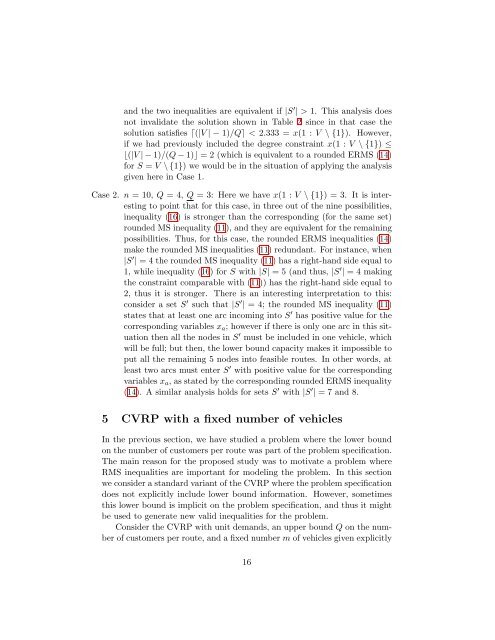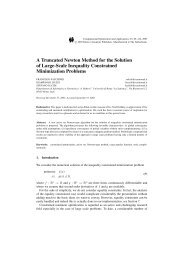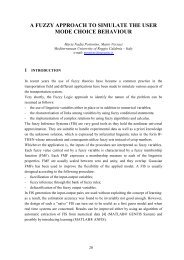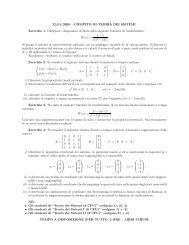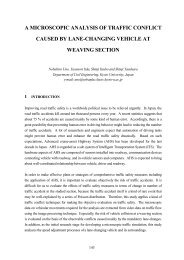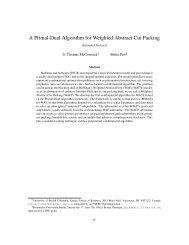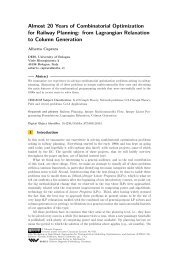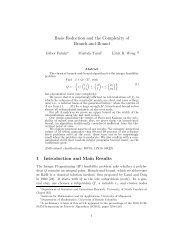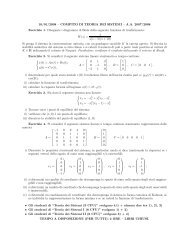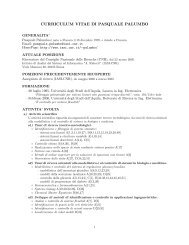Reverse Multistar Inequalities and Vehicle Routing ... - IASI-CNR
Reverse Multistar Inequalities and Vehicle Routing ... - IASI-CNR
Reverse Multistar Inequalities and Vehicle Routing ... - IASI-CNR
You also want an ePaper? Increase the reach of your titles
YUMPU automatically turns print PDFs into web optimized ePapers that Google loves.
<strong>and</strong> the two inequalities are equivalent if |S ′ | > 1. This analysis does<br />
not invalidate the solution shown in Table 2 since in that case the<br />
solution satisfies ⌈(|V | − 1)/Q⌉ < 2.333 = x(1 : V \ {1}). However,<br />
if we had previously included the degree constraint x(1 : V \ {1}) ≤<br />
⌊(|V | − 1)/(Q − 1)⌋ = 2 (which is equivalent to a rounded ERMS (14)<br />
for S = V \ {1}) we would be in the situation of applying the analysis<br />
given here in Case 1.<br />
Case 2. n = 10, Q = 4, Q = 3: Here we have x(1 : V \ {1}) = 3. It is interesting<br />
to point that for this case, in three out of the nine possibilities,<br />
inequality (16) is stronger than the corresponding (for the same set)<br />
rounded MS inequality (11), <strong>and</strong> they are equivalent for the remaining<br />
possibilities. Thus, for this case, the rounded ERMS inequalities (14)<br />
make the rounded MS inequalities (11) redundant. For instance, when<br />
|S ′ | = 4 the rounded MS inequality (11) has a right-h<strong>and</strong> side equal to<br />
1, while inequality (16) for S with |S| = 5 (<strong>and</strong> thus, |S ′ | = 4 making<br />
the constraint comparable with (11)) has the right-h<strong>and</strong> side equal to<br />
2, thus it is stronger. There is an interesting interpretation to this:<br />
consider a set S ′ such that |S ′ | = 4; the rounded MS inequality (11)<br />
states that at least one arc incoming into S ′ has positive value for the<br />
corresponding variables xa; however if there is only one arc in this situation<br />
then all the nodes in S ′ must be included in one vehicle, which<br />
will be full; but then, the lower bound capacity makes it impossible to<br />
put all the remaining 5 nodes into feasible routes. In other words, at<br />
least two arcs must enter S ′ with positive value for the corresponding<br />
variables xa, as stated by the corresponding rounded ERMS inequality<br />
(14). A similar analysis holds for sets S ′ with |S ′ | = 7 <strong>and</strong> 8.<br />
5 CVRP with a fixed number of vehicles<br />
In the previous section, we have studied a problem where the lower bound<br />
on the number of customers per route was part of the problem specification.<br />
The main reason for the proposed study was to motivate a problem where<br />
RMS inequalities are important for modeling the problem. In this section<br />
we consider a st<strong>and</strong>ard variant of the CVRP where the problem specification<br />
does not explicitly include lower bound information. However, sometimes<br />
this lower bound is implicit on the problem specification, <strong>and</strong> thus it might<br />
be used to generate new valid inequalities for the problem.<br />
Consider the CVRP with unit dem<strong>and</strong>s, an upper bound Q on the number<br />
of customers per route, <strong>and</strong> a fixed number m of vehicles given explicitly<br />
16


